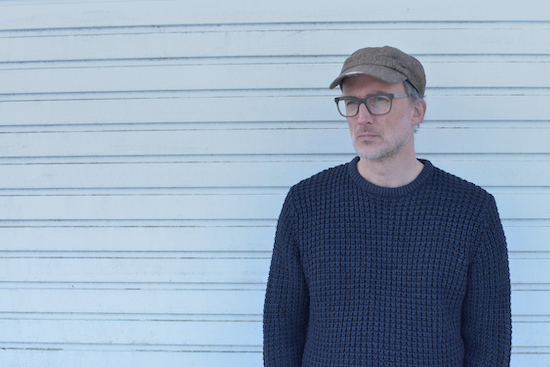Like the Earth’s habitability, Richard Skelton’s new album only occurred through a particular set of circumstances and conditions. After finding “a discarded fifty-year-old vinyl recording of Baroque recorder music…in the Scottish Borders”, the composer built the sprawling, slow-motion soundscapes of Before We Lie Down in Darknesse from one six-second note that rings into the run-out groove; song titles, album name, and theme were taken from Thomas Browne’s seventeenth-century essay Hydriotaphia, Urn Burial.
Richard Skelton is not the first to build a whole work from a single sample (Steve Reich’s early tape pieces spring to mind), but his precise approach is uncommon. We could describe the technique as ‘gigantism’, James Joyce’s term for the expansion of a tiny, fleeting instance into something monumental. Whereas Joyce uses classical allusions, symbolism, and involved language to make the simplest of acts – the clipping of fingernails, an argument, leaving a pub – heroic, farcical, or transcendent, Skelton spins that simple sonic fragment into an interrogation of decay, deep time, and death.
The humdrum colliding with the epochal is one of the key ideas in Hydriotaphia, Urn Burial (which is a pretty great read if you can get pasteth thee wyrd Capitalisation and seventeenth-century turns of Phrase). Browne writes of sepulchral urns found in Norfolk that “Time, which antiquates antiquities, and hath an art to make dust of all things, hath yet spared these minor monuments.” This idea is important in understanding Before We Lie Down in Darknesse. The minor-ness of the “monument” selected by Skelton (the six-second recorder fragment) provokes thoughts about which human creations are “spared” and which aren’t, those that might survive and those that will crumble into dust with the, as Before We Lie Down in Darknesse’s press release anticipates, “impending global environmental collapse and widespread species extinction”. After all, in museums you will see kitchenware alongside swords, and bog bodies on the same floor as golden sarcophagi.
There’s no two ways about it: this is a ghostly album. Rolling waves of sound ring out through misty white noise like foghorns, hanging sluggishly then fading, as if they only have the capacity for two or three notes before collapsing under the strain. The frequent use of glissando suggests a kind of grand, swooning emotional release – it’s one of the reasons why Before We Lie Down in Darknesse seems forever sinking or rising. In a revealing Baker’s Dozen interview with The Quietus, Skelton praised the “morphing, changing, shifting sonorities” of Phuture’s ‘Acid Trax’, and this fondness is evident in the “shifting” quality of Before We Lie Down in Darknesse. It is, I think crucially, not a static record; granular textures, overtones, and hidden melodies are always moving beneath those great, empty-seeming swathes of noise. It’s not the ambient music that suggests still, quiet landscapes, but ambient music that evokes the restless march of time, nature’s (inevitable?) reclamation of human spaces, and Earth’s inner machinery. Insistent crackles on ‘They Closed Their Eyes as Parts Which First Die’ recall both heavy rain on tarpaulin and distant gunfire. You can almost feel the toneless bluster and billow of a squall underneath ‘That the Spirit of One Body Passed Into Another’. (A decent set of headphones will reveal a knobbly topography beneath the fog).
It’s not an unmusical album in any sense, but the moments of intensity are often more timbral than melodic or rhythmic. There’s no sonic identity to that purring, custardy low end, it’s simply there, a presence like the ultra-low frequencies that make up the Earth’s hum. (Ambient artists can be reluctant to use distinct bass (presumably because it can be too, to use Brian Eno’s conception of ambient music, “noticeable”), but Skelton is different). The top layer of ‘And Time Hath No Wings Unto It’ is one grainy, rough-edged tone. ‘To End Their Dayes in Fire’ has a scraping, keening quality that almost sounds like screaming. In that same Baker’s Dozen interview, Skelton said “If we’re looking at what’s had a really formative influence on me, musically, it’s very simple. It’s always been more about texture, repetition and hypnosis and less about variation or change.” Here texture has not been prioritised, but treated as equal (rather than supplementary) to tonality. This makes for thoughtful, fully-rendered music. There’s a subtlety and precision right down to the last comet tail of reverb and slow textural shift, like a habitat left liveable or not by the difference of a few degrees Celsius.
This vein of overcast, unhurried music carries an emotional heft, too. The half-remembered melodies and barest, almost accidental hints of rhythm (courtesy of analogue crackles) on pieces such as ‘Our Light In Ashes’ and ‘That Wish Cannot Unwish Itself’ are charged with a sibylline sense of meaning. It’s an idea that resonates with a YouTube trend where popular songs undergo manipulation of frequency, pitch, tempo, and reverb – see “Danza Kuduro but you’re in a bathroom at your friend’s party in 2011”, or “foo fighters – everlong ( slowed + reverb )”, or a version of ‘God Only Knows’ that’s 800% slower than the original – and somehow take on a sense of distorted familiarity, as if bearing physically the effects of time.
Taken as one, there’s something intimidating about Before We Lie Down in Darknesse. Both the gigantic scale of the sounds – the glacial pace, the textural depth, the cavernous spaces they evoke – and the meaning imbued within them generate a kind of vertigo. There’s a sense that this is of the future (with the music’s evocation of a dead planet) as well as the deep past (the notion of all the art that hasn’t been excavated). It also relates to a precise moment in time: the day that recorder note was committed to tape in the 1970s. This multiplicity of meaning feeds into a contradiction at the heart of this album: on one hand, Skelton imagines a future where all art is, like the recorder sample, interred; but on the other hand, he’s excavated this fragment from obscurity, showing that decay can be counteracted with rebirth. Perhaps these are simply the same contradictory feelings provoked by a future that grows more worrying by the day: that is, that the collapse is inevitable, and yet it is not inevitable. But as Browne points out in Hydriotaphia, Urn Burial, “who knows the fate of his bones, or how often he is to be buried?”



